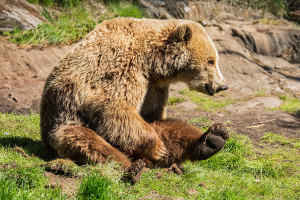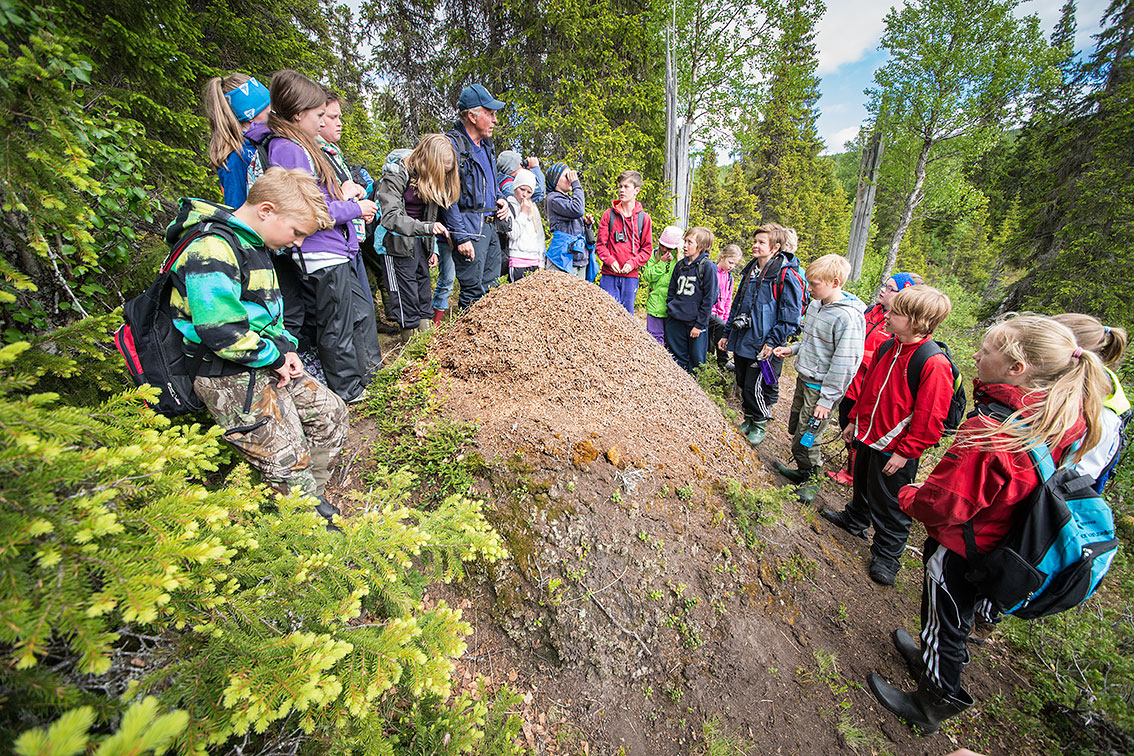Lierne in Nord-Trøndelag, the realm of the bears, is the area of Norway where we find the largest number of bears.
Now, you can join Bjørnecamp – Bear Camp – get up close to the bears and see traces of Master Bruin himself.
Bjørnecamp (Bear Camp) – learn about predators
Joining a bear safari and Bear Camp in the realm of the bears, is a bit like learning how to be a bear detective. How do we recognize bear tracks? What has the bear been eating? What does a flattened bush in the woods tell us? Why is there no bark on that tree? Why has that anthill been torn apart? And how much does a bear eat?
You will know the answers to all of these questions and more after a stay at Bear Camp under the auspices of Lierne National Park Centre. And perhaps you may even get to see a real bear?
Bear tracks on the road
After an introduction to bears and their way of life at Lierne National Park Centre, you are ready to explore the bear’s natural habitat: the forest.
The excitement starts even on the way to camp, when you scout for traces of bears, either in the form of bear faeces on the roadside or bear prints on the road.
Our group found both, and our enthusiasm escalated in step with every new trace we found.
The area with the most bears in Norway – Muru
 The Muru area in the borough of Lierne is the area with the most bears in Norway, and it is here that the country’s first bear camp has been set up. There are few other places where you have a greater chance of seeing unmistakable traces of bears, and traces you will see – in abundance.
The Muru area in the borough of Lierne is the area with the most bears in Norway, and it is here that the country’s first bear camp has been set up. There are few other places where you have a greater chance of seeing unmistakable traces of bears, and traces you will see – in abundance.
At times, you may almost feel that a bear is waiting for you behind the next hill or tree, because it can’t have been long since they were here? Our guide maintains that it is safe to be on bear safari in Lierne’s forests, and our own curiosity makes us continue following him.
“Eating ants was a veritable taste bomb!” – bear camp member.
A torn down anthill tells us that a bear has had what the guide calls a “first-class meal,” and the call to taste the ants comes from his lips with something of a grin. Some of us are tempted, and the conclusion is that ants have a rather strange consistency, but are very, very tasty.
Up close to nature
When at base camp in Lierne, you will learn about bears, wander through the countryside, eat delicious local fare from Lierne and spend the night in a “lavvu” (Sámi-style tent) if you like. All of this in the bears’ own habitat, a fact that will characterize the atmosphere of your entire adventure.
Transport to the bear camp site is included in the price, but if you wish for a closer encounter with the local countryside, you can hire a bike from Lierne Gjestegård (guesthouse) and ride it to the area where bear camp is located. The trip will then take you along the Laksjøen and Sandsjøen lakes with their lovely view of, amongst other things, Blåfjella-Skjækerfjella National Park.
How can you tell if bears have been in the area?
• Animal faeces with unmistakable signs of what the animal has eaten, such as berries and grass
• Dug up anthills – where the bear has had a first-rate meal, with a tang of lemon
• Scraped up trees – the bear has confirmed its presence
• Flattened bushes in the woods – the bear has been scratching its tummy
What to do if you encounter a bear:
Over the years a lot of advice has been in circulation, like the suggestion that ladies should lift their skirts, or that you should run downhill because that is difficult for bears, but much of this is probably things that have worked once, and have later been presented as the key to success. The really good advice, however, is as follows:
• Keep calm
• Talk to the bear so that it realizes that you are a living being
• Withdraw quietly from the scene, to show that you do not intend to threaten the bear
Nordli town centre is about 250 km (three and a half hours drive via Grong) north of Trondheim. It is 72 km from Grong to Lierne.













